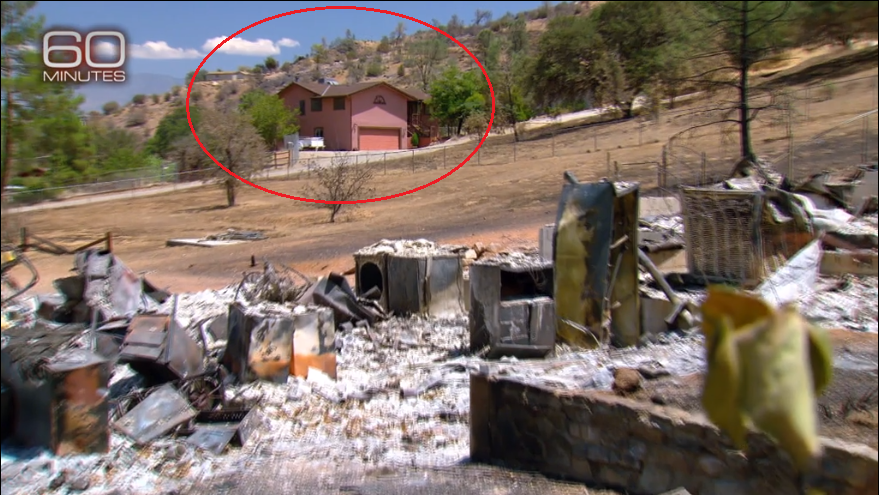*How Sea "Farming" Removes CO2 From Ocean
(*Nov 5 2018: update, below.)
This "Three-D Sea Farming" news segment weeks ago on 60 Minutes was a hopeful report in our journey to course-correct climate change.
A fisherman or "sea hunter" became a sea farmer, growing produce and livestock inside "columns" of water, cubic square feet of ocean, instead of plots of land. Seaweed up top, "sausage nets" of muscles just below seaweed, cylindrical cages of scallops growing at mid-tier, and oysters growing at sea floor. Cool seaweed-seeding column technology and oyster cages shown in the CBS video of the seaweed story, now online here.
The more big fires racing through cities and towns, the more CO2-sequestering trees and brush are destroyed, the more CO2 is released into the air. The more CO2 in the atmosphere, the hotter the atmosphere becomes, which heats the polar icecaps, ... (somewhere here more CO2 is getting into the ocean, "acidification" the oceanographers call it.)
The warmer ocean heats icecaps from underneath, which could cause them to melt faster. The white surfaces of the ice managed to repel sunlight, bounce it back out of the atmosphere. The blue ocean surface absorbs sunlight (and heat.) Aha! That's how CO2 gets into the ocean.
Who wants "sea greens" for dinner? Safeway doesn't carry them yet, but Whole Foods does.
-----------------
Further Reading:
"Paper" author Mark Kurlansky is best known for his mega-selling deep-dive book Cod: A Biography of the Fish That Changed the World. amazon.com
Researcher and author Paul Greenberg told Terry Gross about his year-long experiment to eat fish at every meal and document the health effects in his book The Omega Principle. He stopped taking fish oil supplements, and now eats "farmed biovalves" including mussels, clams, oysters which "actually improve the marine environment even as we grow them." npr.org
A researcher teamed with a popular French cartoonist to end French government subsidies sustaining the bottom-trawling over-fishing of black scabbard fish, and roundnose grenadier that nobody bought or ate. (Greenberg, above, said the over-fishing of these bottom prey base led to the 1980s-era Cod crashes documented by Kurlansky, top.) goldmanprize.org
* -------- UPDATE ------>
Bliki Update Nov 5, 2018: This blog post still attracts web hits.
Here's a free video from CBS This Morning featuring the same sea farmer. His name's "Bren Smith":

This work by AJ Fish is licensed under a Creative Commons Attribution-NonCommercial 4.0 International License.
This "Three-D Sea Farming" news segment weeks ago on 60 Minutes was a hopeful report in our journey to course-correct climate change.
A fisherman or "sea hunter" became a sea farmer, growing produce and livestock inside "columns" of water, cubic square feet of ocean, instead of plots of land. Seaweed up top, "sausage nets" of muscles just below seaweed, cylindrical cages of scallops growing at mid-tier, and oysters growing at sea floor. Cool seaweed-seeding column technology and oyster cages shown in the CBS video of the seaweed story, now online here.
The more big fires racing through cities and towns, the more CO2-sequestering trees and brush are destroyed, the more CO2 is released into the air. The more CO2 in the atmosphere, the hotter the atmosphere becomes, which heats the polar icecaps, ... (somewhere here more CO2 is getting into the ocean, "acidification" the oceanographers call it.)
The warmer ocean heats icecaps from underneath, which could cause them to melt faster. The white surfaces of the ice managed to repel sunlight, bounce it back out of the atmosphere. The blue ocean surface absorbs sunlight (and heat.) Aha! That's how CO2 gets into the ocean.
Who wants "sea greens" for dinner? Safeway doesn't carry them yet, but Whole Foods does.
-----------------
Further Reading:
"Paper" author Mark Kurlansky is best known for his mega-selling deep-dive book Cod: A Biography of the Fish That Changed the World. amazon.com
Researcher and author Paul Greenberg told Terry Gross about his year-long experiment to eat fish at every meal and document the health effects in his book The Omega Principle. He stopped taking fish oil supplements, and now eats "farmed biovalves" including mussels, clams, oysters which "actually improve the marine environment even as we grow them." npr.org
A researcher teamed with a popular French cartoonist to end French government subsidies sustaining the bottom-trawling over-fishing of black scabbard fish, and roundnose grenadier that nobody bought or ate. (Greenberg, above, said the over-fishing of these bottom prey base led to the 1980s-era Cod crashes documented by Kurlansky, top.) goldmanprize.org
* -------- UPDATE ------>
Bliki Update Nov 5, 2018: This blog post still attracts web hits.
Here's a free video from CBS This Morning featuring the same sea farmer. His name's "Bren Smith":

This work by AJ Fish is licensed under a Creative Commons Attribution-NonCommercial 4.0 International License.




